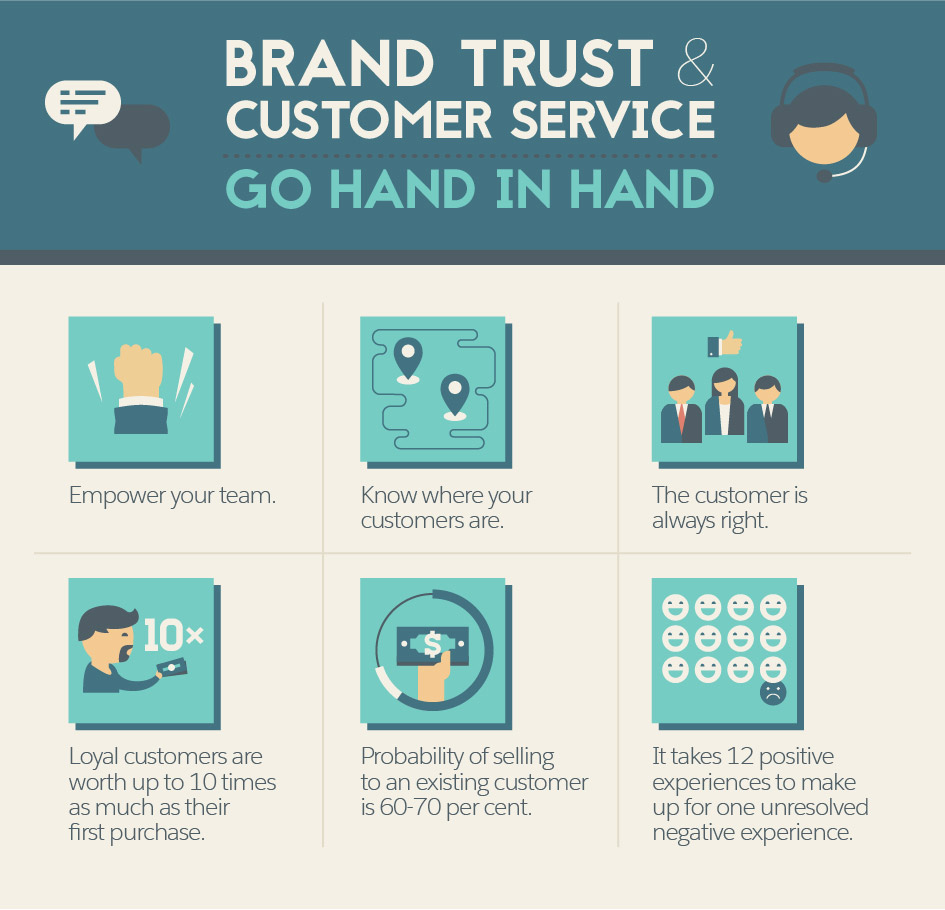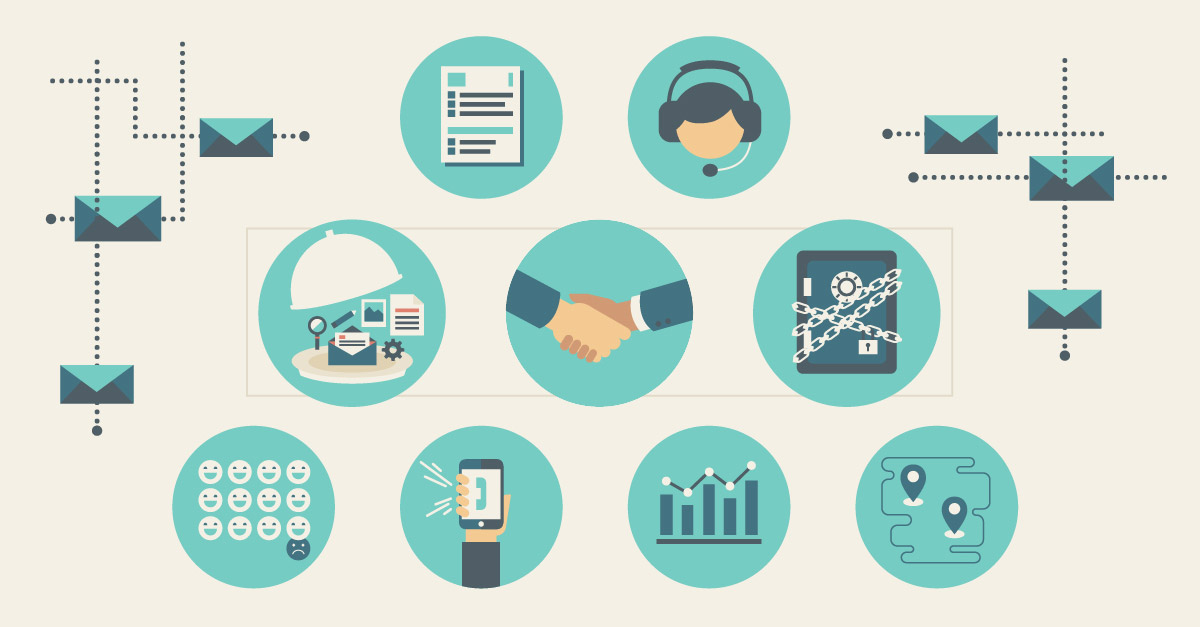When making a purchase, 92 per cent of consumers trust recommendations from friends and family over all forms of advertising. In fact, they trust their friends and family 9 times more than they trust advertising.
For brands, this presents both a challenge and an opportunity. Companies can no longer rely solely on advertising and expect consumers to make purchases based on campaign promises. They can, however, reach and connect with customers and potential customers in new ways, and these new methods can generate the trust and loyalty companies need to succeed.
How can brands earn and keep the trust of their customers? This article explores reputation management and the best methods companies can use to interact with their customers.
How to Earn & Keep Customer Trust
Earn and Keep Customer Trust with Content, Customer Service, and Privacy, and Respect
1. Content
- On-Site Content
- Visitors want to see contact information.
- The average website visitor leaves a site after 10-20 seconds.
- Research your website traffic to make sure it’s optimized for visitors.
- 75% of customers want personalized messages and offers.
- Visitors want to see contact information.
- Email Content
- Write an appealing, personalized subject line
- Personalized email content improves click-through rates by 14 per cent and conversion rates by 10 per cent.
- Write an appealing, personalized subject line
- Off-Site Content
- Monitor review sites and encourage satisfied customers to review your company.
- 88 per cent of consumers trust online review sites as much as personal recommendations.
- 69 per cent of consumers like to read product reviews written by trusted experts before making a purchase
- Monitor review sites and encourage satisfied customers to review your company.
2. Customer Service
- Empower Your Team
- Know Where Your Customers Are
- Answer emails and tweets within 1 hour
- Answer phone calls within 3 minutes
- Use a social media monitoring tool to address mentions quickly.
- Set up Google alerts to monitor mentions.
- Check your referral traffic data to identify sites driving traffic to your website.
- Monitor call times and content to ensure phone support is timely and issues are addressed properly.
- The Customer is Always Right
3. Privacy & Respect
- Ensure your systems are compliant and up to date.
- Alert consumers of any issues or potential issues as soon as possible.
- Don’t automatically store information after a purchase unless the customer gives permission.
- Let customers know exactly what you do with their information.

As marketers, we spend most of our time thinking about how we can get customers in the door and on the site. Whether through commercials, print advertising, email marketing, search engine marketing, or social media, our goal is to reach our target audience. We need to get them interested in what we have to offer and then earn their money.
But how often do we earn their trust?
As we cement ourselves in this Internet-focused era, when customers not only have a bigger voice but also expect more from brands, marketers must build trust with customers by addressing their concerns and giving them the information they need as quickly as possible. There are two factors to take into consideration when trying to earn and keep customers’ trust: content and customer service.
1. Content
Content is the cornerstone of a marketing strategy and can make a campaign even more profitable. Successful brands create content with the right tone and voice that addresses customer needs, and ensure they give customers the information they actually want. It goes beyond just a blog post or whitepaper and touches everything marketers do.
On-Site Content
Statistics show the average website visitor leaves a site after 10 to 20 seconds. That means you have 10 to 20 seconds to make sure potential customers can find the information they are looking for.
In the 2015 B2B Web Usability Report, research found visitors want to see contact information on a website; it also found that contact information helps customers trust a business. Personalization is another great way to build trust: A study from the Aberdeen Group found 75 per cent of customers like it when brands personalize messages and offers.
Do you know what your customers look for? Look at your website analytics to evaluate bounce rates, visitor paths, site search data, and exit pages. You can also run surveys or user tests to get real-time feedback from site visitors. Use your findings to improve your customers’ experience on your website and make sure they find what they need when they visit.
Email Content
Businesses Send 116.2 Billion Emails Every Day
If one envelope equals 1,000 emails then 1,344,907 business emails are sent every second.

An estimated 116.2 billion business emails are sent and received every day: That amounts to 1,344,907 per second. To increase the odds of your email being read, its content needs to be personalized and the subject line needs to appeal to recipients. One third of email recipients open email based on subject line alone, and personalized subject lines have 26 per cent higher open rates than non-personalized emails. Then, once open, personalized emails improve click-through rates by 14 per cent and conversion rates by 10 per cent. These staggering email statistics prove businesses must focus on creating personalized emails that give customers information specific to their needs. If a person gives you an email address to download a whitepaper, don’t send them generic emails on a daily basis. Nothing makes a potential customer unsubscribe faster than spam. Off-Site Content Off-site content is just as important as on-site content when it comes to trust. Businesses must be aware of how they are perceived online. A report from BrightLocal shows 88 per cent of consumers trust online review sites as much as personal recommendations. Additionally, 69 per cent of consumers like to read product reviews written by trusted experts before making a purchase. Here’s how companies can encourage people to write positive reviews: Ask existing customers to review your business Contact consumers who have made multiple purchases or have been long-time customers and ask them for a review. Additionally, reach out to those who have already said something positive about you online. Give customers something to talk about Positive reviews come from happy customers. Research the best tactics to satisfy your customers and get them talking.
2. Customer Service
Brand Trust and Customer Service Go Hand in Hand
- Empower your team.
- Know where your customers are.
- The customer is always right.
- Loyal customers are worth up to 10 times as much as their first purchase.
- Probability of selling to an existing customer is 60-70 per cent.
- It takes 12 positive experiences to make up for one unresolved negative experience.

Brand trust and customer service go hand in hand; 76 per cent of shoppers view customer service as a test of how much a brand values them. Here are three factors to consider when improving your customer service:
Empower your team
“I’d like to speak to a manager.” When a customer uses this phrase, they’re talking to someone who is unwilling or unable to resolve an issue. Great customer service starts by empowering your employees with the information and ability to help people, and who also make customers feel appreciated and valued. The Harvard Business Review has a great breakdown on how companies can empower their customer service teams.
Know where your customers are
- Customers want their problems resolved fast. People expect both email requests and Twitter complaints to be answered within an hour, while three minutes is the going rate for phone calls. That isn’t much time!
- Know where your customers ask questions and request support. Make sure you answer in a timely manner.
- Use a social media monitoring tool to address any brand, product, or service name mention quickly. Set up alerts though Google or other tools to get emails when your name is mentioned in an article or website.
- Check your referral traffic data to identify any forums or sites driving traffic to your website. You may find customers you weren’t aware of.
- Monitor call times and content to ensure phone support is timely and issues are addressed properly.
Along with employee empowerment, it’s imperative to provide customer support across any and all channels. With these two pieces in place, you can then concentrate on the final piece of the puzzle.
The customer is always right
We’ve all heard that expression. While in some cases it isn’t true, helping customers resolve their issues goes a long way in earning and keeping their trust. Your employees need the ability to work with customers to give them what they want. Looking for tips? See how to handle challenging customer service scenarios.
Final Thoughts
As marketers, we face more challenges than ever before. New mediums launch every day, customer expectations continually rise, and technology struggles to keep up with security issues. While no one can promise everything will go according to plan, we can prove we value customers’ business and will do everything in our power to keep them as a customer. “Trust is earned, not given.” Show your customers why they should trust you and your marketing efforts. Your bottom line will reap the rewards.

Share "The Psychology of Trust in Marketing: How to Earn It and How to Keep It" On Your Site
| <p><strong>Click To Enlarge</strong><br /><br /> <a href="https://www.salesforce.com/ca/blog/2015/08/psychology-of-trust-in-marketing.html" _rte_href="https://www.salesforce.com/ca/blog/2015/08/psychology-of-trust-in-marketing.html" target="_blank"> <img src="https://www.salesforce.com/content/dam/blogs/ca/Blog%20Posts/psychology-trust-marketing-embed.jpg" _rte_src="https://www.salesforce.com/content/dam/blogs/ca/Blog%20Posts/psychology-trust-marketing-embed.jpg" alt="The Psychology of Trust in Marketing: How to Earn It and How to Keep It" width="600px" border="0" /> </a> </p> <p>Via <a href="https://www.salesforce.com/ca/cloud-computing/" _rte_href="https://www.salesforce.com/ca/cloud-computing/" target="_blank">Salesforce</a> </p> |



